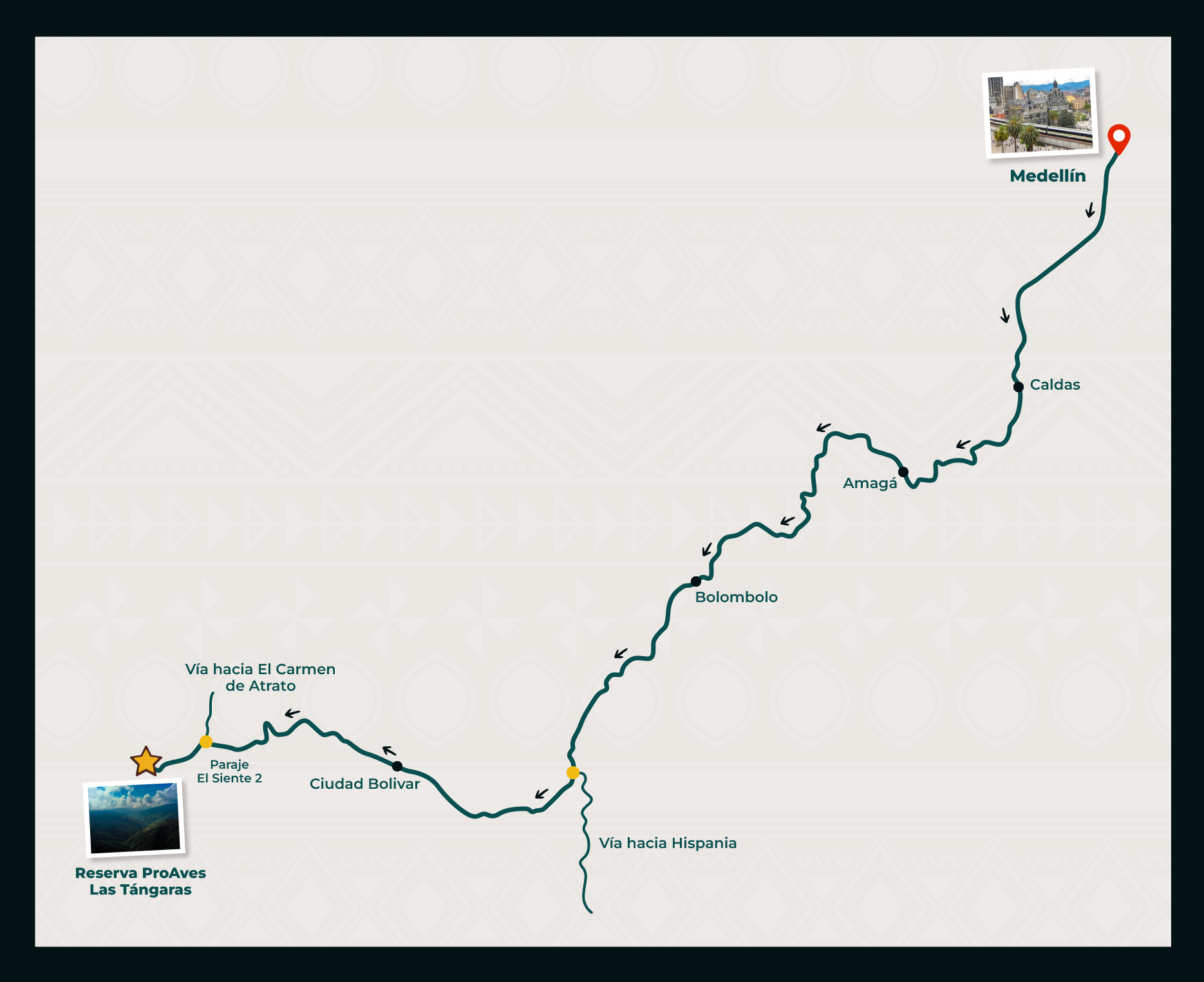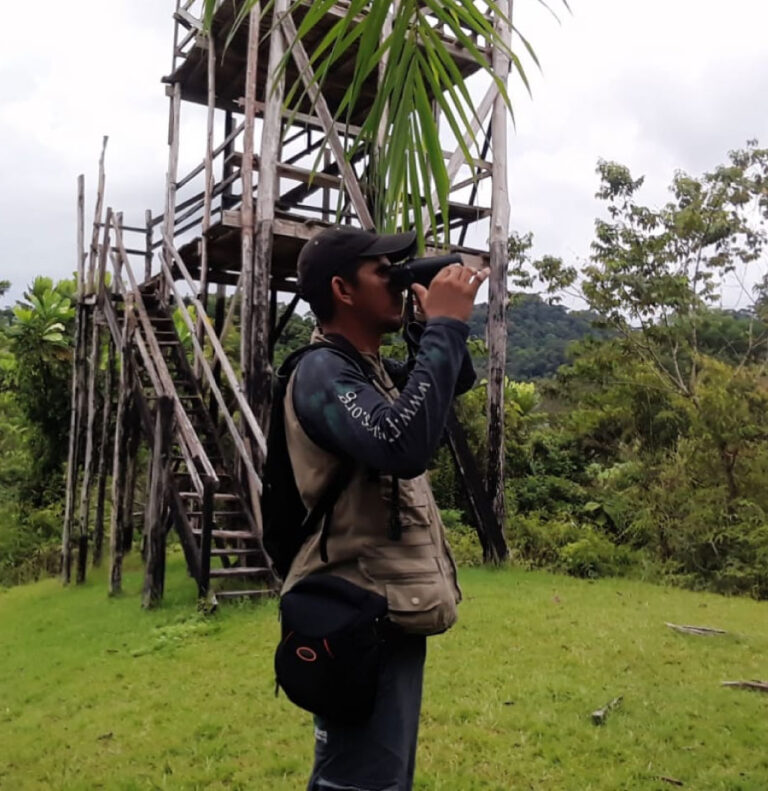Fundación ProAves – por la conservación en el país de las aves

The ProAves Las Tángaras Reserve was created to protect the habitat of two endemic bird species: the Golden-ringed Tanager (Bangsia aureocincta) and the Black-and-gold Tanager (Bangsia melanochlamys), as well as other species of importance for the Biogeographic Chocó.
Date of Establishment:
September
2010

Ecosystem:
Tropical forests
Temperature:
Maximum of 17°C to 28°C

Climate:
Fog and rainfall prevail throughout the year.
Altitudinal Range:
Between 1,300 to 3,400 meters above sea level.
KEY SPECIES
In this conservation area, close to:


Entre las aves registradas en la zona están:
La Perdiz Santandereana (Odontophorus strophium), el Inca negro (Coeligena prunellei), la Amazilia
Buchicastaña (Amazilia castaneiventris), el Torito Dorsiblanco (Capito hypoleucus), el Hormiguero de
Parker (Cercomacra parkeri), el Tapaculo Ratón Scytalopus latebricola), el Tordo montañero
(Macroagelaius subalaris) y el hormiguero pico de hacha (Clytoctantes alixii).
Así mismo, es posible ver:
La Rana Venenosa (Myniobates virolinensis) y mamíferos como el
Oso de Anteojos (Tremarctos ornatus), el Puma (Puma concolor)
HOW TO GET TO LAS TÁNGARAS PROAVES RESERVE?
- Public Transportation:
Take a bus from the Surandina company at the Southern Terminal heading to the municipality of Carmen de Atrato, Chocó.
Once at Paraje El Siete, you can take an express transport to the Reserve facilities, approximately a 15-minute ride.
It’s not necessary to go all the way to the municipality of Carmen de Atrato.
- Private Transportation:
Any vehicle is suitable for transportation to the Nature Reserve.
Approximate travel time: 5 hours.
Note: From the cabin of the Nature Reserve to the trails, there is a distance of 8 kilometers, so visitors should arrange transportation in advance or have their own.
LOCATION
Las Tángaras ProAves Reserve is located in the municipality of Carmen de Atrato, department of Chocó.
- Ruta: Medellín - Caldas- Amagá - Bolombolo - Ciudad Bolivar - Paraje El Siete - Reserva ProAves Las Tángaras (Paraje El Ocho).
Las Tángaras
Proaves Reserve
A BIRD PARADISE IN THE
CHOCÓ BIOGEOGRAPHIC REGION
Among the registered birds in the area, the following stand out:
The Tatamá Tangara (Bangsia aureocincta), the Black-and-gold Tanager (Bangsia melanochlamys), the Chocó Vireo (Vireo masteri), the Purplish-mantled Tanager (Iridosornis porphyrocephala), the Indigo Flowerpiercer (Diglossa Indigotica), the White-bearded Manakin (Margarornis stellatus), and several species of hummingbirds such as Coeligena wilsoni, Boissaneaua jardini, and Heliodoxa imperatrix.
Additionally, it is possible to observe amphibians from the families Centrolenidae, Bufonidae, and Strabomantidae, with the notable presence of salamanders from the genus Bolitoglossa.
Regarding flora, there is a remarkable presence of numerous epiphytes and orchids (gen. Epidendrum sp), large trees including encenillos (Weinmannia sp), and aguacatillos (Ocotea sp.), among others.
ACCOMMODATIONS
The Nature Reserve offers lodging for 20 people in comfortable rooms with electricity, private bathrooms, and hot water.
AT THE PROAVES LAS TÁNGARAS RESERVE, YOU CAN ALSO:
Birdwatching
of endemic and native birds
Contemplate
the Atrato River
Observe
nocturnal wildlife
Watch hummingbirds
at the Reserve's feeding stations
Mountain bike to Gorrion de Andivia Reserve
and Guaduas community (with your own equipment)
Photography of landscapes
fauna, and flora
Previous slide
Next slide
We recommend a minimum stay of 2 to 3 nights to fully enjoy the activities and the variety of wildlife.

Additionally, you will have access to:
- Internet in common areas, which may be intermittent. Take advantage of your stay in our Reserve to connect with nature!
- Water, coffee, and tea station.
Our reservation rates do not include extra services such as meals or transportation; any of these will have an additional cost and must be requested in advance via WhatsApp: +57 323 434 34 87.
- Due to our policies for the care and conservation of our species, we do not allow pets. We invite you to leave your pets in a safe place.
TEN EN CUENTA LAS SIGUIENTES RECOMENDACIONES:
RESERVACIÓN
Haz tu reserva con 24 horas de anticipación.
Las reservaciones sin cita previa no están garantizadas y dependen de la disponibilidad del momento.
CHECK IN Y CHECK OUT
La Reserva Natural abre a las 6:00 a.m. y cierra a las 8:00 p.m.
Hora de ingreso a la habitación: Desde las 3:00 p.m. y hora de salida de la habitación: Máximo a las 10:00 a.m.
POLÍTICAS DE CANCELACIÓN
No se realizará reembolso o devoluciones de dinero por ningún concepto.
La reservación es susceptible a cambio de acuerdo a disponibilidad de alojamiento en la Reserva Natural. Los cambios a la reservación inicial deben ser solicitados con mínimo 15 días de anterioridad al correo electrónico: visit@conservation.co
ALIMENTACIÓN
Infórmanos de cualquier problema de salud, alergias o requerimientos alimenticios. En la Reserva ProAves Chamicero de Perijá, fomentamos la gastronomía típica colombiana y podemos adaptarla a sus necesidades, para esto, es importante que nos informe previamente sus restricciones alimenticias.
Nuestro menú excluye la carne roja como una forma de reducir el impacto en el medio ambiente.
NO COLECTAR
Te pedimos respetar los recursos naturales de la Reserva ProAves. La colección de cualquier material biológico no está permitida.
TRANSPORTE
Es necesario viajar en un vehículo 4×4 adaptado para las condiciones de la carretera.
ROPA
¡Recuerda que el clima en Colombia es muy cambiante! Te recomendamos traer calzado adecuado para caminar, chaqueta impermeable, ropa con manga larga , gorra para el sol y protector solar.
LINTERNA
La Reserva Natural a menudo tiene cortes de energía eléctrica, así que trae una linterna y disfruta de la conexión con la naturaleza sin la distracción de la tecnología moderna.
MOSQUITOS
No es necesario vacunarse contra la fiebre amarilla. Sin embargo, te recomendamos usar repelente ya que al estar en contacto con la naturaleza puede haber mosquitos.
PROHIBIDO INGRESAR ALCOHOL
Prohibido el ingreso de bebidas alcohólicas a la Reserva Natural.
SENDEROS INTERNOS
Sigue las instrucciones del personal de la Reserva Natural y permanece en los senderos establecidos.
SUSTAINABILITY & CONSERVATION
AT LAS TÁNGARAS
ProAves Las Tángaras Reserve was established in September 2010 to protect the habitat of two endemic bird species: the Tatamá Tangara (Bangsia aureocincta) and the Black-and-gold Tanager (Bangsia Melanochlamys). The municipality of Carmen de Atrato signed the memorandum of understanding to be part of the Alliance for Zero Extinction of Colombia in October 2010.
The protected area is one of the most diverse and important tropical forest sites in the world, protecting an elevation range from 1,250 to 3,400 meters above sea level. This conservation sanctuary protects the Atrato River basin, one of the most important tributaries of Chocó, which serves as a vital economic resource for thousands of inhabitants living in poor rural communities.
This strategic land acquisition helps consolidate a buffer zone that protects this conservation area from rapid and unsustainable colonization and strengthens the protection of several isolated indigenous communities. A total of sixteen private properties in the area were acquired to create the Las Tángaras Nature Reserve.
Many water sources originate in the area, highlighting the La Sánchez stream, a tributary of the Atrato River.
Regarding flora, there is a remarkable presence of numerous epiphytes and orchids (gen. Epidendrum sp), large trees including encenillos (Weinmannia sp), and aguacatillos (Ocotea sp.), among others.
It presents a high diversity index with records so far of 250 bird species, belonging to 15 orders and 42 families, highlighting the Tatamá Tangara (Bangsia aureocincta), the Black-and-gold Tanager (Bangsia melanochlamys), the Chocó Vireo (Vireo masteri), the Purplish-mantled Tanager (Iridosornis porphyrocephala), the Indigo Flowerpiercer (Diglossa Indigotica), and the White-bearded Manakin (Margarornis stellatus), as well as several species of hummingbirds such as Coeligena wilsonii, Boissaneaua jardini, and Heliodoxa imperatrix.
In amphibians, it is common to find specimens from the families Centrolenidae, Bufonidae, and Strabomantidae, with the notable presence of salamanders from the genus Bolitoglossa.


